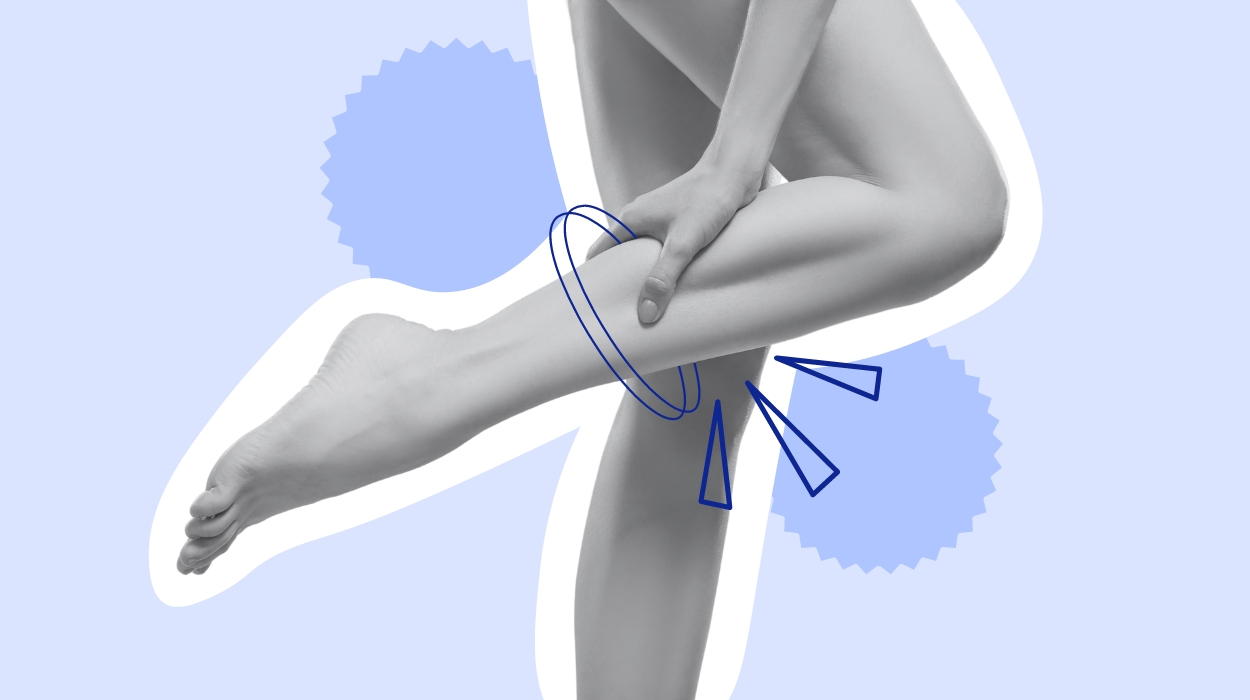Your calves are located at the back of your lower legs. Like other body parts, these areas can accumulate fat and appear heavier than your thighs. Fat calves can make you feel self-conscious and uncomfortable.
Losing calf fat can make your legs look slimmer and more attractive. However, the problem is that you cannot target only calf fat loss but instead need to focus on overall body fat loss. Losing weight requires a balance of a healthy diet and strength training exercises.
So, how do you achieve slim and toned calves? In this article, we have compiled exercise, diet, and lifestyle tips on how to lose calf fat and tone your calf muscles.
How To Reduce Calf Fat: 10 Best Exercises
Having fat calves can make you feel self-conscious and uncomfortable. The good news is you can do something about it. There are exercise, diet, and lifestyle tips that can help you lose calf fat and have toned calves.
The best exercises to make calves smaller include the following:
- Calf Stretching.
- Standing Calf Raises.
- Seated Calf Raises.
- Weighted Sumo Squat with Calf Raise.
- Plie Calf Raises.
- Arm Plank and Knee Dips.
- Jump Squats.
- Stair Climbing.
- Skater Hops.
- Endurance Running.
How To Lose Calf Fat: 10 Exercises To Slim Down Your Calves
Your calves not only make your legs look beautiful, but those muscles support your body weight and movements such as walking, running, jumping, and climbing. While helpful when trying to get rid of excess calf fat and slim your calves, exercises are also crucial in making them stronger.
The following are calf fat reduction exercises that will help you achieve slim calves:
Calf Stretching
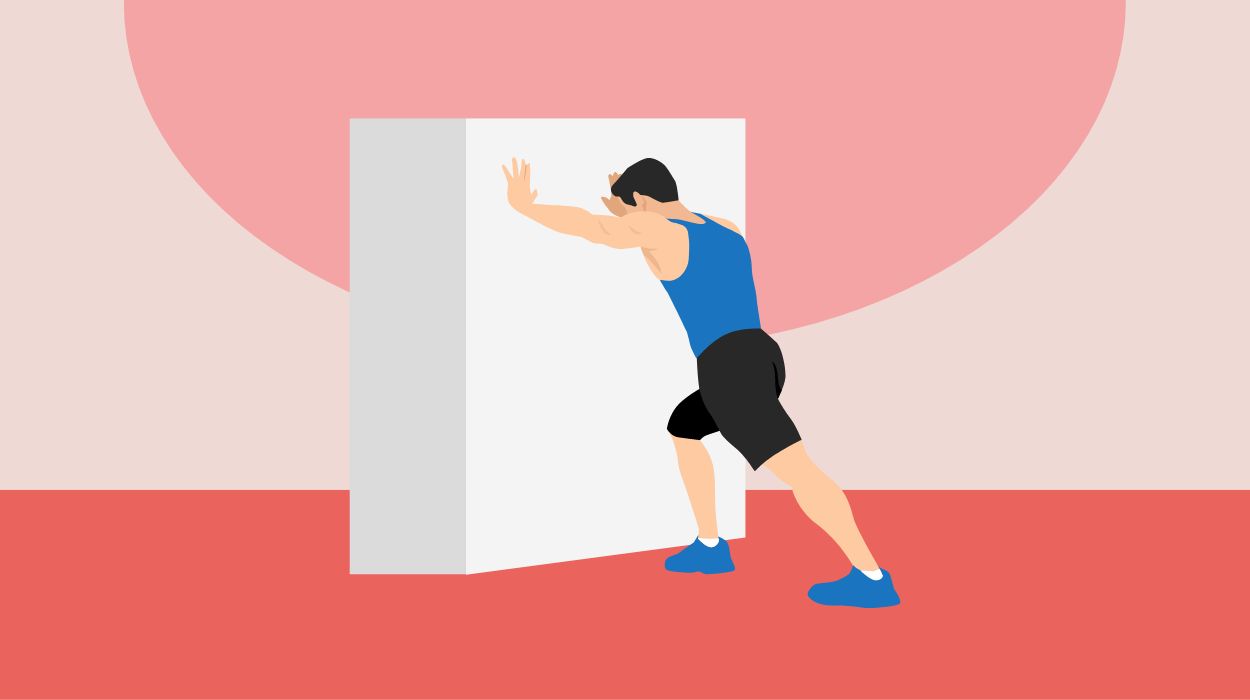
A simple way to tone your calf muscles is by doing calf stretches.
How to do:
- Stand upright at arm’s length from a wall while facing the wall.
- Place your right foot directly in front of you between you and the wall.
- Place your left foot a step back away from the wall.
- Leaning forward, place your elbows and arms on the wall.
- Lower your butt and core while pressing firmly into the wall with your forearms. Your right leg should be upright or slightly bent, while the left leg bends as you stretch your calf and hamstring.
- Hold for 20-30 seconds on each leg.
- Switch legs and repeat the same steps.
Tips:
- Keep your back leg straight and your heel firmly planted on the ground to target the calf muscles effectively.
- Avoid bouncing or jerking during the stretch; instead, maintain a steady and gentle pressure to prevent injury.
- Perform the stretch after your workout, when your muscles are warmed up, for enhanced flexibility and reduced muscle tightness.
Optimal Sets and Reps: 3 sets of 2-3 reps per leg.
Standing Calf Raises
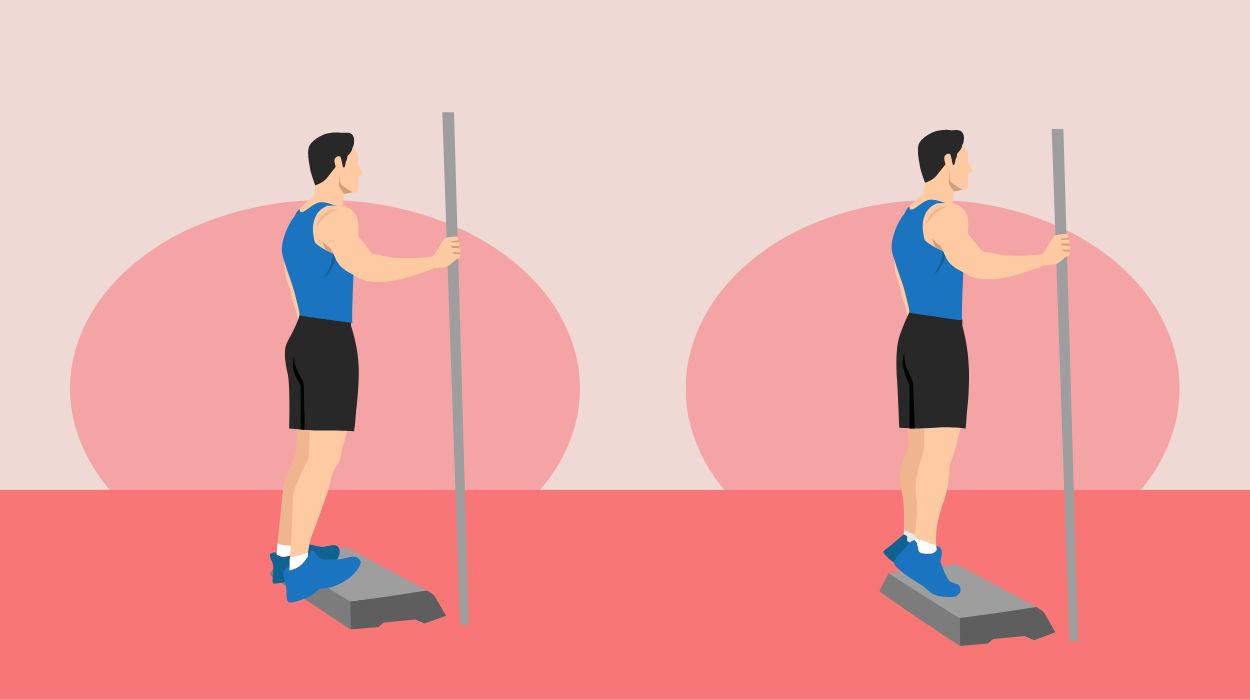
Standing calf raises the target and strengthens the calves and hamstrings.
How to do:
- Stand straight with your feet kept at shoulder-width apart.
- Raise your heels while balancing on the balls of your feet.
- Hold that pose for 10 seconds, and then slowly lower your feet to the floor.
Tips:
- Focus on maintaining balance throughout the exercise by keeping your weight evenly distributed between both feet.
- To increase the range of motion and calf activation, perform the exercise on an elevated surface, like a step or calf raise machine, allowing your heels to drop lower than your toes.
- Control the movement by lifting and lowering your heels in a slow and controlled manner to maximize muscle engagement and reduce the risk of injury.
Optimal Sets and Reps: 3 sets of 12-15 reps.
Seated Calf Raises
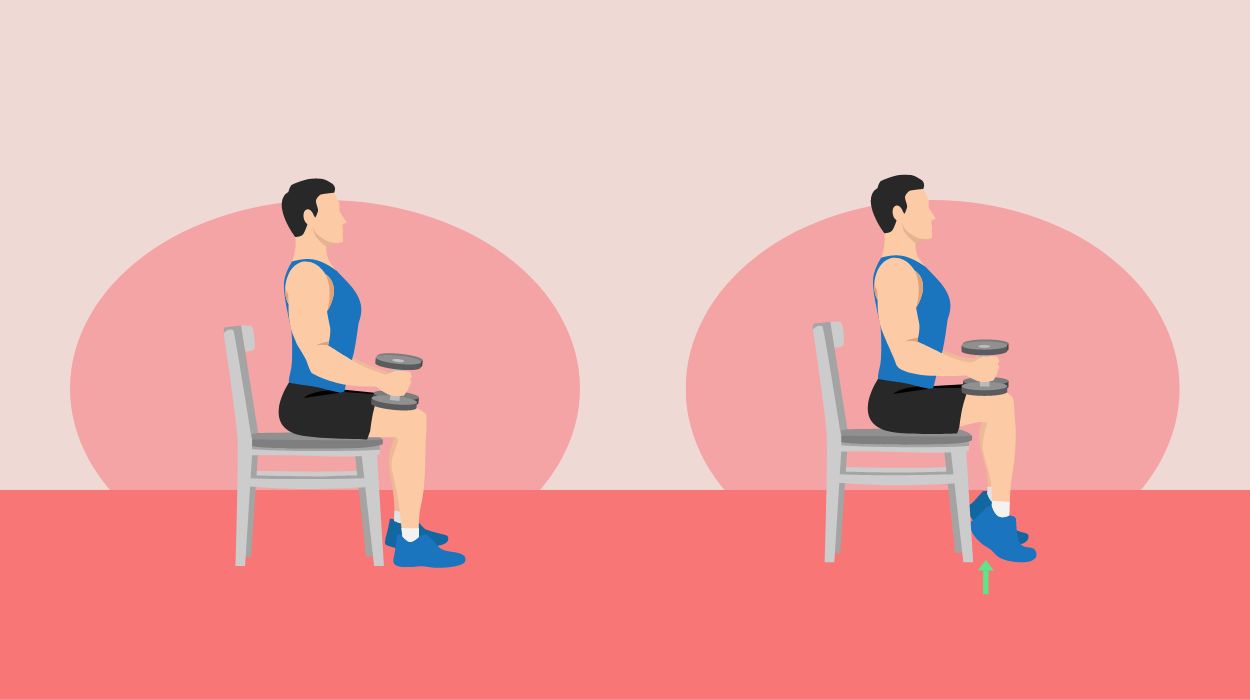
This calf exercise requires sitting with dumbbells. You can increase the weights weekly.
How to do:
- Sit on a chair or stool with your feet flat on the floor, shoulder-width apart.
- Take a dumbbell in each hand and hold both of them on your thighs, just above your knees.
- Straighten your spine and look straight.
- Raise your heels slowly while keeping the balls of your feet on the floor.
- Keep this pose for one to three seconds, and slowly lower your feet to the floor.
Tips:
- Maintain a straight back and engage your core to stabilize your upper body while performing the exercise.
- Focus on the full range of motion by lifting your heels as high as possible and lowering them until your calves are stretched to maximize muscle engagement.
- Gradually increase the weight or resistance as you progress to continue challenging your calf muscles and promoting strength and growth.
Optimal Sets and Reps: 3 sets of 12-15 reps.
Weighted Sumo Squat With Calf Raise
In this exercise, you perform calf raises with weights and get into a sumo squat position. A sumo squat is a variation of the traditional squat. In a sumo squat, your feet are wide apart with your knees and toes pointing outwards instead of in parallel facing forward as in a traditional squat.
How to do:
- Stand with your back straight, feet wide apart, and dumbbells in your hands.
- Turn your feet out while keeping your back straight and chest out.
- Bend your knees and lower your torso until your thighs are aligned with your hips.
- Hold this pose for three to five seconds. Then, slowly raise your torso back into standing position.
- While raising your torso, raise your heels.
- Gently place your heels on the floor, flex your knees, and return to the sumo squat position.
Tips:
- Keep your chest up and your core engaged throughout the entire movement to maintain stability and proper form.
- Maintain a slow and controlled pace when lowering into the squat and rising onto your toes for the calf raise to maximize muscle engagement and reduce the risk of injury.
- As you progress, you can increase the weight gradually or use a resistance band for added challenge, but always prioritize proper form and safety.
Optimal Sets and Reps: 3 sets of 12-15 reps.
Plie Calf Raises
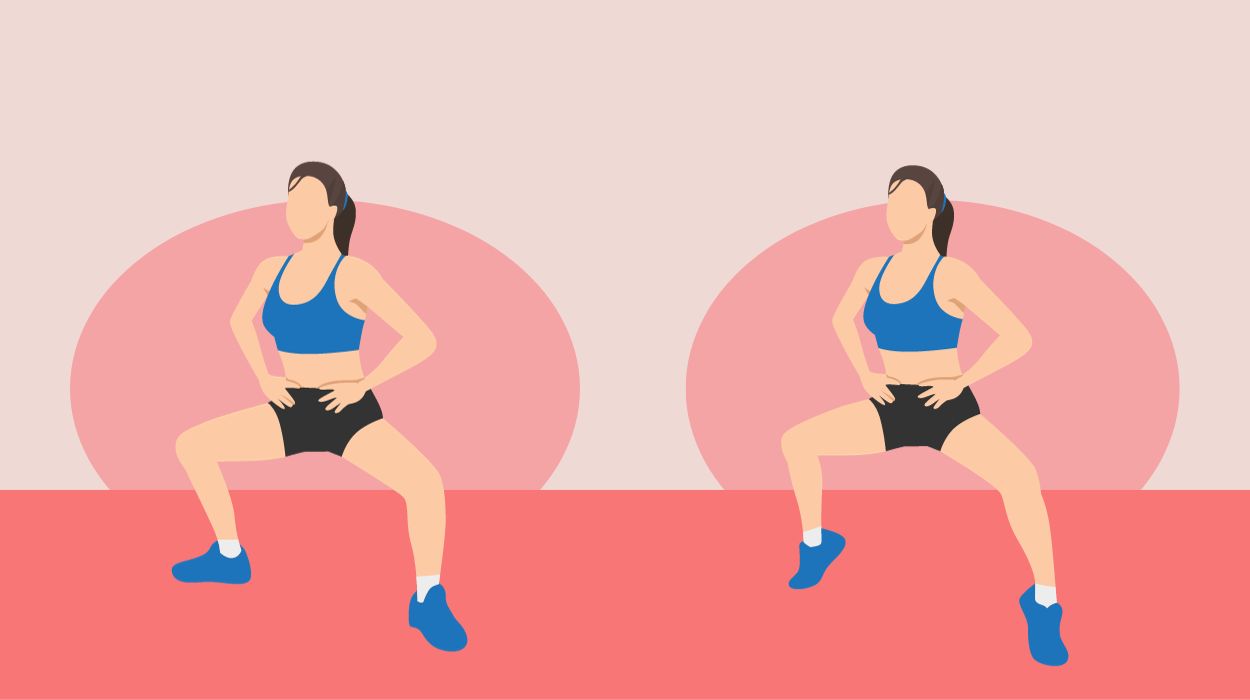
This calf exercise does not need any special equipment.
How to do:
- Stand with your feet wide apart (wider than shoulder-width).
- Get into a sumo squat position with your back straight and hands extended in front of you.
- Lift your heels slowly from the ground while keeping your toes intact on the floor.
- Immediately lower your heels till they are about to touch the floor and light them again.
Tips:
- Keep your core engaged and maintain an upright posture throughout the exercise to ensure proper form and balance.
- Focus on the full range of motion by lifting your heels as high as possible and lowering them until you feel a stretch in your calves to maximize muscle engagement.
- To increase the challenge, you can hold onto dumbbells or a barbell with a manageable weight or use a resistance band for added resistance during the exercise.
Optimal Sets and Reps: 3 sets of 12-15 reps.
Arm Plank And Knee Dips
This exercise is similar to elbow planks but also incorporates knee dips to work your calf muscles and burn fat.
How to do:
- Get into a plank position: Elbows on the ground, knees, and thighs raised and off the ground.
- Flex your right knee so that it touches the floor. Lift it back into the plank position.
- Repeat with your left knee.
Tips:
- Keep your neck in a neutral position, avoiding any excessive tilting or lifting, to maintain proper alignment and reduce strain on your neck and spine.
- Exhale as you dip your knee toward the ground and inhale as you return to the plank position to coordinate your breathing with the movement.
- To intensify the exercise, you can increase the duration or the number of repetitions but always prioritize maintaining proper form throughout the set.
Optimal Sets and Reps: 3 sets of 12-15 reps.
Jump Squats
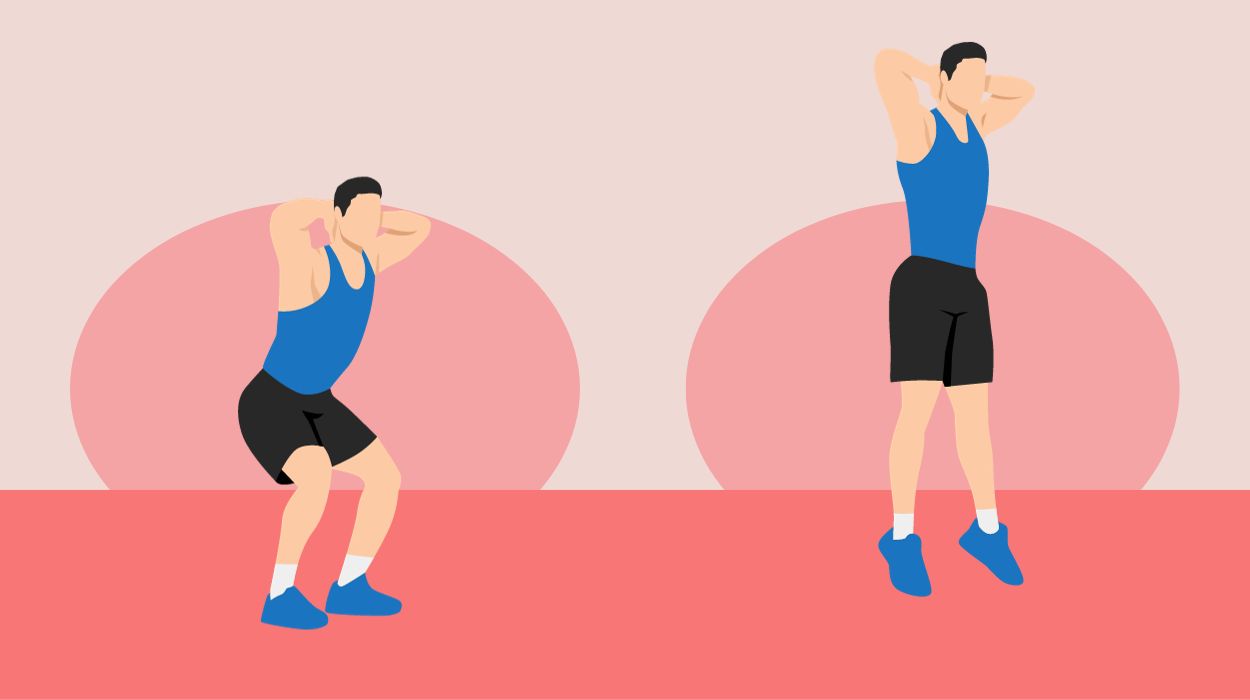
Jump squats target your calves, hamstrings, quads, and glutes, and can help you shed excess fat.
How to do:
- Stand straight and keep your feet shoulder-width apart.
- Keep your chest out and shoulders back.
- Bend your knees and bend your buttocks outward into a squat or sitting posture.
- Raise your hands above your head in a swift, jerk-like motion and jump.
- Land gently on the floor.
Tips:
- Keep your back straight and chest up throughout the exercise to maintain proper form and prevent rounding of the spine.
- Engage your core muscles to stabilize your body during the jumps, promoting balance and control.
- Make sure to land with a slight bend in your knees to reduce impact on your joints and prevent excessive strain.
Optimal Sets and Reps: 3 sets of 10-12 reps.
Stair Climbing
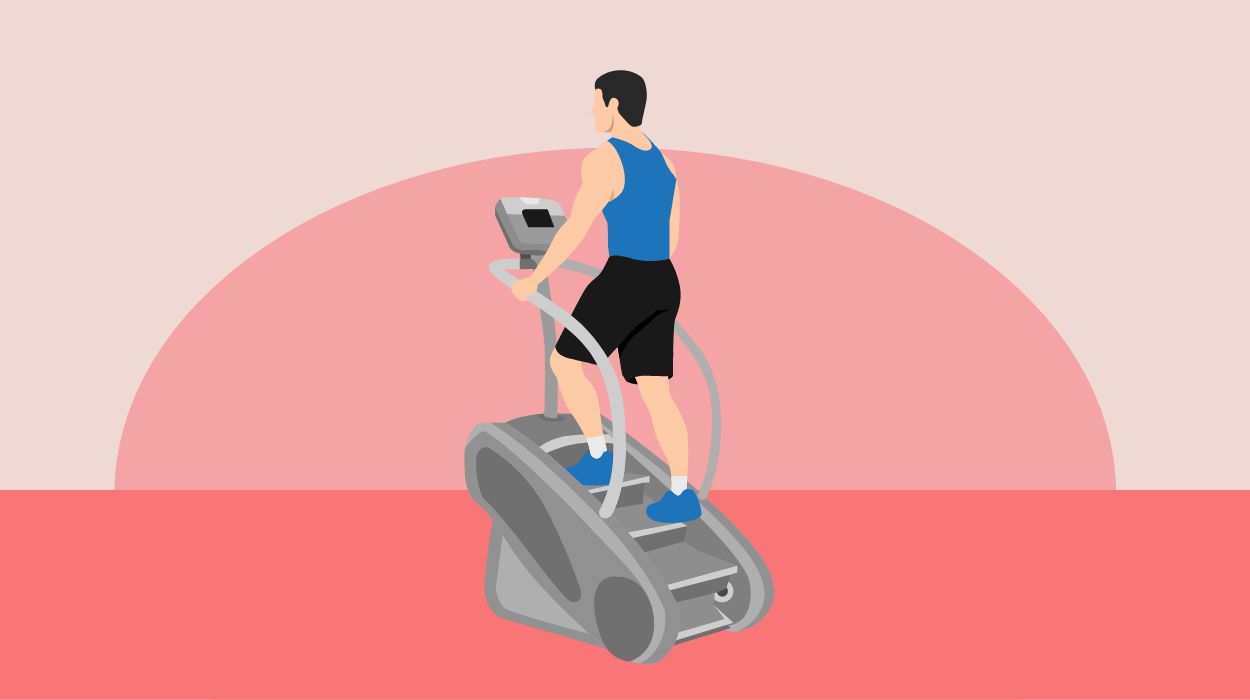
Just like the name suggests, stair climbing involves climbing stairs. It is a very easy and convenient calf exercise.
How to do:
- You can use the stairs at home or work, or use a stair machine.
- Do a warm-up by stretching, jogging, or jumping on a spot.
- Go up and down the stairs at a moderate pace.
- Use your toes while climbing instead of your whole foot so that pressure is exerted on your calves.
- Increase your pace gradually.
Tips:
- Focus on your breathing, inhaling, and exhaling in a steady rhythm to support your cardiovascular effort throughout the workout.
- Use the handrail for balance and support if needed, especially when ascending or descending a steep set of stairs, to prevent accidents or strain.
- To make the exercise more challenging, you can increase the speed of your climb or add weight by wearing a backpack or holding dumbbells, but always prioritize safety and proper form.
Optimal Sets and Reps: 3 sets of 10-15 minutes of continuous stair climbing.
Skater Hops
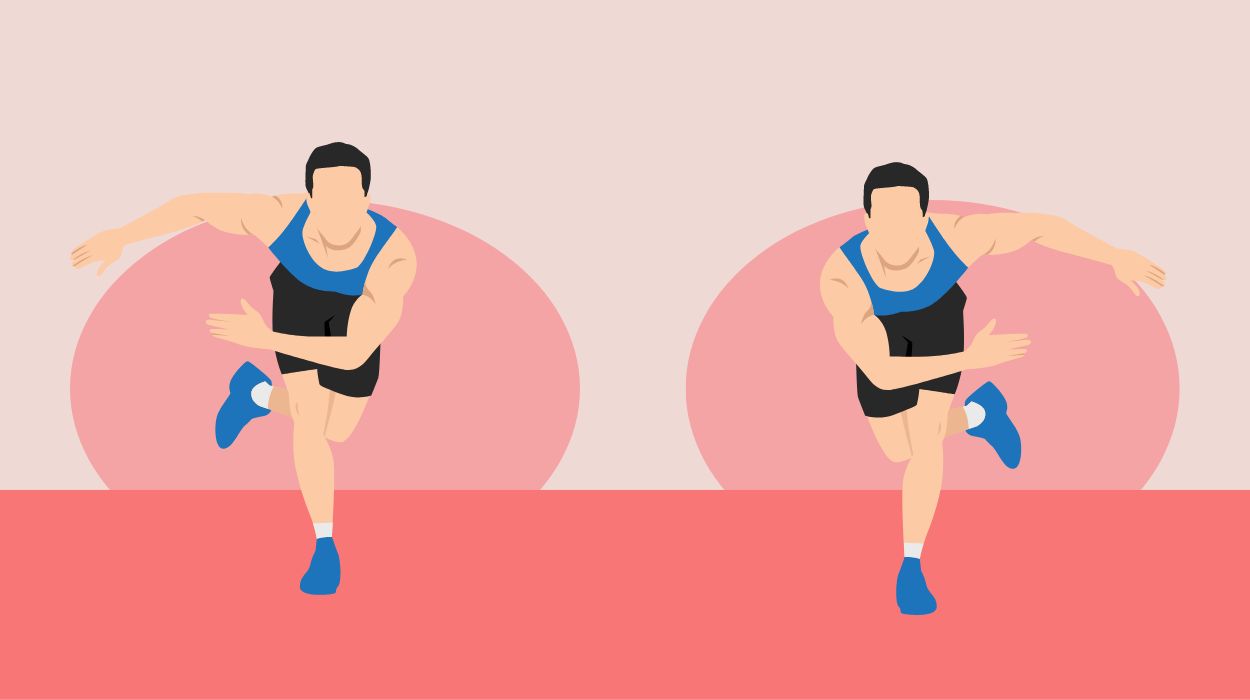
This is another calf exercise that helps reduce fat. It targets your calves, quads, and hamstrings.
How to do:
- Stand straight with your legs together.
- While standing, put your weight on your right foot and bend your right knee slightly.
- Lift your left leg off the floor.
- Bound to your left by pushing off on your right foot.
- Almost immediately, you land on your left foot, lifting your right leg off the floor behind you as if you are running.
- Keep hopping from right to left and back.
Tips:
- Keep your chest up and your core engaged to maintain proper posture and balance throughout the exercise.
- Land softly on the balls of your feet, avoiding heavy or jarring landings to protect your joints and prevent injury.
- As you progress, you can increase the distance of your hops or add a small hurdle or obstacle to jump over to intensify the exercise and challenge your agility further.
Optimal Sets and Reps: 3 sets of 12-15 hops on each leg.
Endurance Running
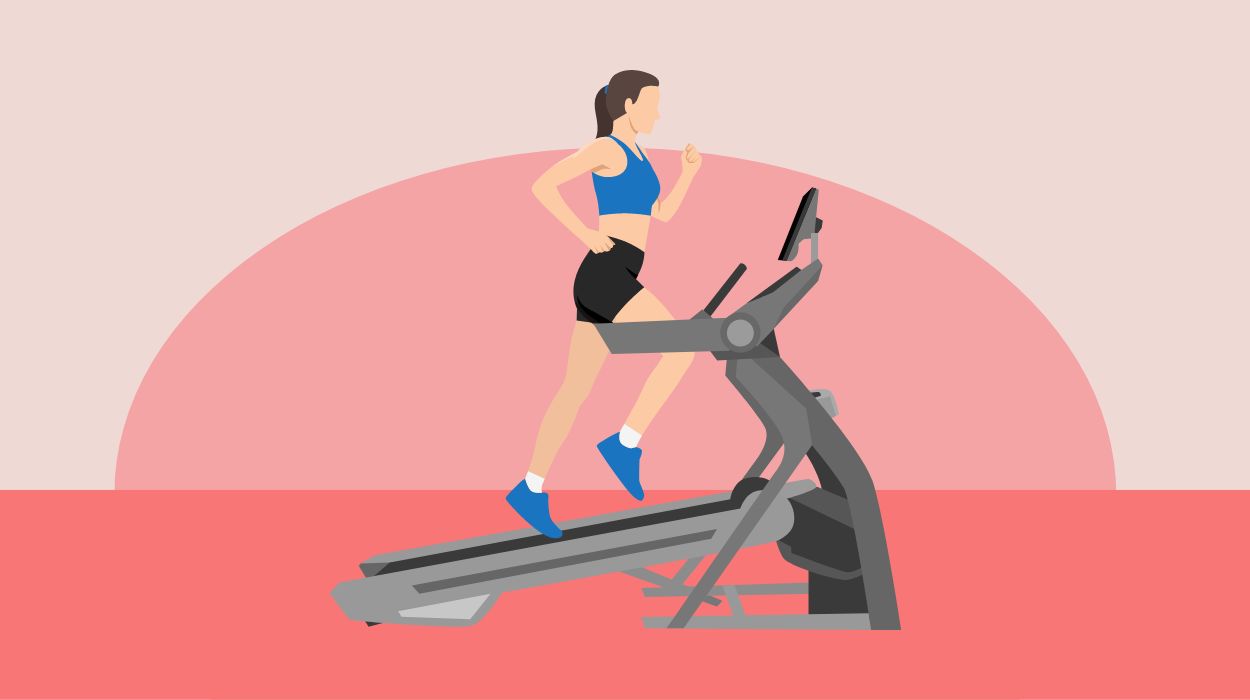
As simple as running is, it is efficient at helping you lose fat. Running targets your entire body, including your calves.
How to do:
- Warm up for five to ten minutes. You could stretch, jog, or spot jump.
- Then, slowly start jogging on a track, road, or treadmill with a three-degree incline to build enough resistance and activate muscle activity.
- Then start running. The goal is to run slowly but for a longer period. This helps you burn body fat.
Tips:
- Incorporate variations in terrain, such as hills or trails, to challenge different muscle groups and add variety to your runs.
- Use proper running shoes that provide adequate support and cushioning to reduce the risk of injuries and discomfort during long runs.
- Pay attention to your body’s signals, and if you experience pain, fatigue, or any unusual discomfort, listen to your body and rest or adjust your pace accordingly to prevent overexertion.
Optimal Sets and Reps: Aim for a duration of 30-60 minutes of continuous running.
These are 10 different calf exercises that help shed fat and tone your calf muscles. These can be performed in addition to plyometric lunges, strength training exercises, and single-leg squats. These exercises can also help you lose weight when paired with other diet and lifestyle modifications.
What Causes Stubborn Fat On Calves?
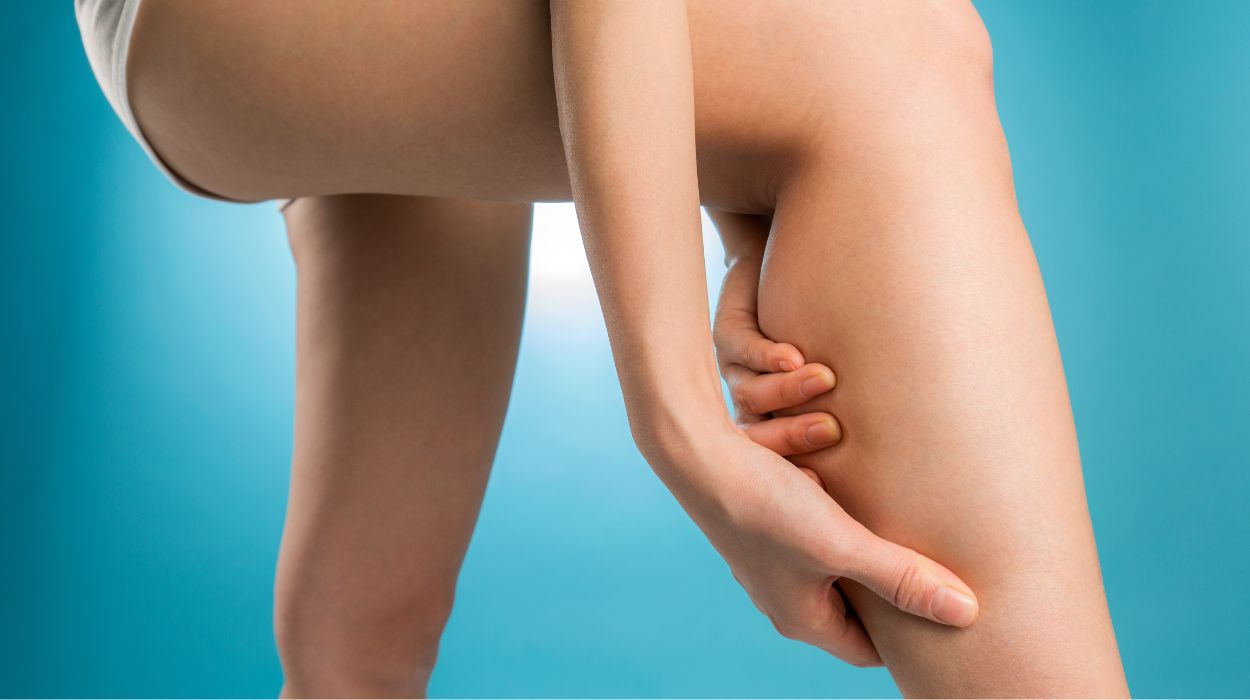
Are you wondering why you have bigger calves or why it seems challenging to get rid of the calf fat? Multiple factors may be responsible for the stubborn fat in calves. These include genetics, lifestyle choices, and preexisting health conditions.
Genetics
Genetics determine your body type and where and how fat is stored. There are three main body types or somatotypes[1] categorized by different levels of body fat percentage. Those with the highest body fat percentage tend to have larger body frames and typically bigger calf sizes.
Lipedema
Lipedema[2] is a health condition that causes subcutaneous fat to build up in your lower body. Fat typically builds up in your glutes, thighs, and calves. It is normally seen in women with a few case studies in men.
The causes of lipedema are unknown, but research suggests it may be an inheritable condition. It can result in big calves, pain, and difficulty walking, so it’s important to seek medical attention to lose calf fat, no matter male or female, as soon as weight gain becomes abnormal.
Poor Lifestyle Choices
Unhealthy lifestyle choices can increase your fat mass. Eating foods high in carbs, refined sugar, and fats can cause obesity,[3] and in turn stubborn calf fat.
A sedentary lifestyle is a risk factor for increased body fat percentage[4] and can, in turn, cause fat to build up in your calves. You need to be physically active to burn calories and avoid fat storage.
Other Ways On How To Get Rid Of Calf Fat
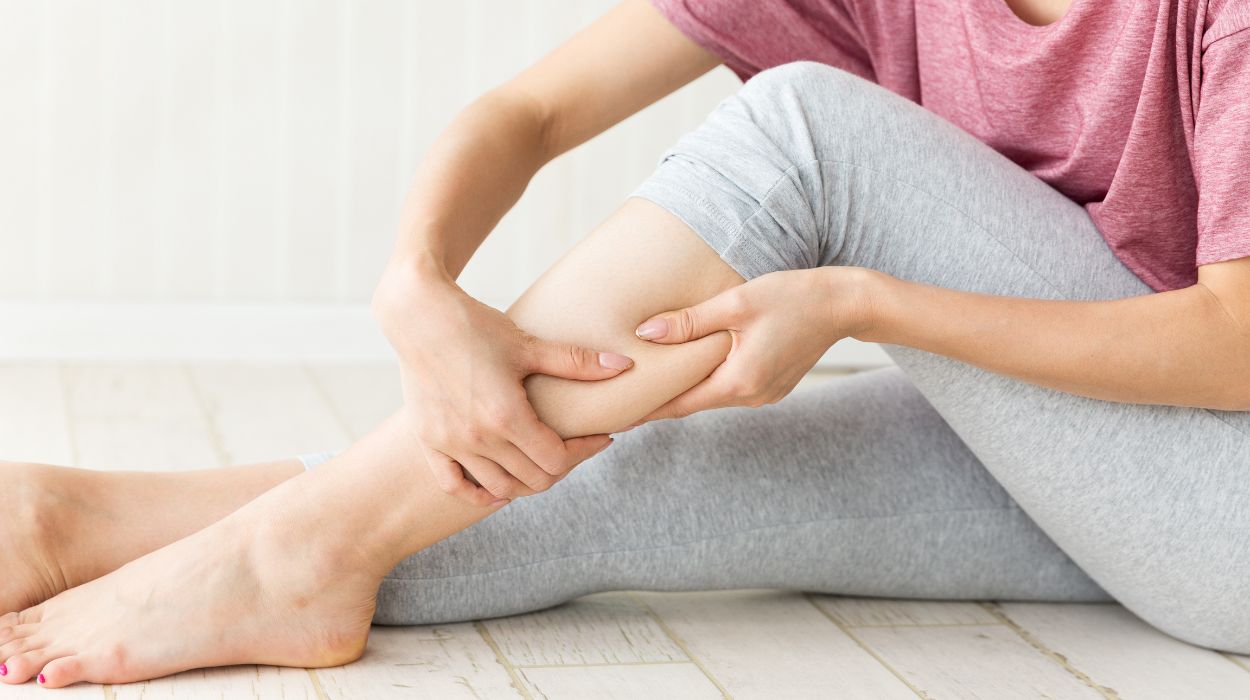
Here are some extra diet and lifestyle tips to get defined calves.
Diet And Dietary Habits
Developing and adhering to certain dietary habits can help you get slimmer and well-defined calves. Losing weight requires eating a caloric-deficit diet. This means you consume fewer calories than you burn per day.
It’s crucial to increase your protein and fiber intake. These make you feel full and help you avoid overeating.
Cut back on sugar, carbs, and unhealthy fats. These are fattening foods, including processed foods, fried foods, sugary beverages, and pastries. Rather than help you lose calf fat, they cause you to gain weight.
Also, control your meal portions[5] and avoid late-night eating[6] to prevent weight gain. You can also consider fat burners and weight loss supplements.
Remember to drink plenty of water and stay hydrated. Water boosts your metabolism[7] and helps burn fat.
Lifestyle Tips
Working out may sound like the best way to lose weight in calves. However, it is important to not overdo it.
When you start exercising, more workouts will lead to greater weight loss. However, overworking your muscles may start leading to bulkier calves.
Ensure you get enough sleep and rest. Short sleep duration[8] is associated with increased BMI and body fat mass.
There are some additional ways to reduce your calf size. You may get a botox injection,[9] or calf reduction surgery like liposuction.[10]
Conclusion
It is possible to accumulate fat at the back of your legs and have big calves. While losing fat in your lower legs may be more difficult than in other parts of your body, several lifestyle modifications can help lose calf fat.
Exercises help tone your calves and maintain a healthy body weight. Other measures such as a healthy and balanced diet, adequate hydration, and sleep can also help effectively get rid of calf fat.
Frequently Asked Questions
Your calves contain both muscle and small deposits of fat. Higher muscle content makes calves firmer, while higher fat content makes calves softer.
The fastest way is to work out with calf reduction exercises. Perform these exercises regularly while prioritizing a healthy diet, adequate sleep, stress management, and other lifestyle improvements.
Focus on losing weight all over rather than overworking your calf muscles. Opt for low-impact cardio exercises like walking and stair climbing. This will help you burn calories and store fat without building muscle.
Yes, walking can help you lose calf fat. Walking is an easy, low-impact exercise that can help you burn fat in your calves.
It is possible to have big calves even with a slim frame. That’s because large calves are not necessarily linked to obesity but to genetics. Genetics determine your body type and where and how fat is stored.
Trying to target fat in a specific area can be challenging. To effectively lose fat in your calves, you need to focus on overall body fat loss.
Avoid doing lots of calf exercises. Performing calf exercises excessively will build more muscle and make your calves bulkier. So reducing the frequency of your calf workouts is how to lose calf muscle.
Calf exercises primarily tone and strengthen your calf muscles. However, there are exercises and weight loss tips that can help you lose thigh fat and overall body fat.
 Expert's opinion
Expert's opinion